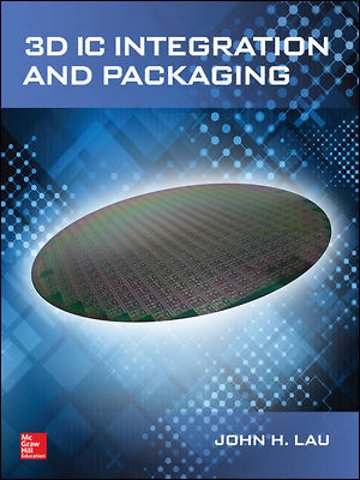3D IC Integration and Packaging
Samenvatting
Publisher's Note: Products purchased from Third Party sellers are not guaranteed by the publisher for quality, authenticity, or access to any online entitlements included with the product.
A comprehensive guide to 3D IC integration and packaging technology
3D IC Integration and Packaging fully explains the latest microelectronics techniques for increasing chip density and maximizing performance while reducing power consumption. Based on a course developed by its author, this practical guide offers real-world problem-solving methods and teaches the trade-offs inherent in making system-level decisions. Explore key enabling technologies such as TSV, thin-wafer strength measurement and handling, microsolder bumping, redistribution layers, interposers, wafer-to-wafer bonding, chip-to-wafer bonding, 3D IC and MEMS, LED, and complementary metal-oxide semiconductor image sensors integration. Assembly, thermal management, and reliability are covered in complete detail.
3D IC Integration and Packaging covers:
• 3D integration for semiconductor IC packaging
• Through-silicon vias modeling and testing
• Stress sensors for thin-wafer handling and strength measurement
• Package substrate technologies
• Microbump fabrication, assembly, and reliability
• 3D Si integration
• 2.5D/3D IC integration
• 3D IC integration with passive interposer
• Thermal management of 2.5D/3D IC integration
• Embedded 3D hybrid integration
• 3D LED and IC integration
• 3D MEMS and IC integration
• 3D CMOS image sensors and IC integration
• PoP, chip-to-chip interconnects, and embedded fan-out WLP
Specificaties
Inhoudsopgave
r/>9.1 Introduction<br/>9.2 Design Philosophy<br/>9.3 The New Design<br/>9.4 Equivalent Model for Thermal Analysis<br/>9.5 Interposer with Chip/Heat Spreader on Its Top Side and Chip on Its Bottom Side<br/>9.5.1 The Structure<br/>9.5.2 Material Properties<br/>9.5.3 Boundary Conditions<br/>9.5.4 Simulation Results<br/>9.6 Interposer with Chip/Heat Spreader on Its Top Side and Chip/Heat Slug on Its Bottom Side<br/>9.6.1 The Structure and Boundary Conditions<br/>9.6.2 Simulation Results<br/>9.7 Interposer with Four Chips on Its Top Side with Heat Spreader<br/>9.7.1 The Structure<br/>9.7.2 Boundary Conditions<br/>9.7.3 Simulation Results<br/>9.7.4 Summary and Recommendations<br/>9.8 Thermal Performance between 2.5D and 3D IC Integrations<br/>9.8.1 The Structures<br/>9.8.2 The Finite Element Models<br/>9.8.3 Material Properties and Boundary Conditions<br/>9.8.4 Simulation Results—Low-Power Applications<br/>9.8.5 Simulation Results—High-Power Applications<br/>9.8.6 Summary and Recommendations<br/>9.9 Thermal Management System with TSV Interposers with Embedded Microchannels<br/>9.9.1 The Structure<br/>9.9.2 Adaptor<br/>9.9.3 Heat Exchanger<br/>9.9.4 Carriers<br/>9.9.5 System Integration<br/>9.9.6 Theoretical Analysis of the Pressure Drop<br/>9.9.7 Experimental Process<br/>9.9.8 Results and Discussions<br/>9.9.9 Summary and Recommendations<br/>9.10 References<br/>10 Embedded 3D Hybrid Integration<br/>10.1 Introduction<br/>10.2 Trends of Optoelectronic Products<br/>10.3 The Old Design—High-Frequency Data Link on PCB Using Optical Waveguides<br/>10.3.1 Polymer Optical Waveguide<br/>10.3.2 Simulations—Optical Coupling Models<br/>10.3.3 Simulations—System Link Design<br/>10.3.4 Assembly of the OECB<br/>10.3.5 Measurement Results of the OECB<br/>10.3.6 Summary and Recommendations<br/>10.4 The Old Design—Embedded Board-Level Optical Interconnects<br/>10.4.1 Fabrication of Polymer Waveguide<br/>10.4.2 Fabrication of the 45° Micro-Mirror<br/>10.4.3 Assembly Process of the OECB<br/>10.4.4 Fabrication Process of Vertical-Optical Channel<br/>10.4.5 Final Assembly<br/>10.4.6 Summary and Recommendations<br/>10.5 The New Designs<br/>10.6 An Embedded 3D Hybrid Integration Design Example<br/>10.6.1 Optical Design, Analysis, and Results<br/>10.6.2 Thermal Design, Analysis, and Results<br/>10.6.3 Mechanical Design, Analysis, and Results<br/>10.6.4 Summary and Recommendations<br/>10.7 Semi-Embedded TSV Interposer with Stress Relief Gap<br/>10.7.1 Design Philosophy<br/>10.7.2 Problem Definition<br/>10.7.3 Semi-Embedded TSV Interposer Subjected to Operating Condition<br/>10.7.4 Semi-Embedded TSV Interposer Subjected to an Environmental Condition<br/>10.7.5 Summary and Recommendations<br/>10.8 References<br/>11 3D LED and IC Integration<br/>11.1 Introduction<br/>11.2 Status and Outlook of Haitz’s Law<br/>11.3 LED Has Come a Long Way!<br/>11.4 Four Key Segments of LED Products<br/>11.4.1 Substrates for LED Epitaxial Deposition<br/>11.4.2 LED Device Fabrication<br/>11.4.3 Packaging Assembly and Test of LED<br/>11.4.4 LED Final Product Assembly<br/>11.4.5 Outlook of LED Products<br/>11.5 3D LED and IC Integration<br/>11.5.1 HP FCLED and Thin-Film FCLED<br/>11.5.2 3D LED and IC Integration Packages<br/>11.5.3 Manufacturing Process of 3D LED and IC Integration<br/>11.5.4 Summary and Recommendations<br/>11.6 2.5D IC and LED Integration<br/>11.6.1 LED Packaging Using Si-Substrate with Cavities and Cu-Filled TSVs<br/>11.6.2 Si-Substrate with Cavity and TSVs for LED Packaging<br/>11.6.3 LED Wafer-Level Packaging<br/>11.6.4 Summary and Recommendation<br/>11.7 Thermal Management of 3D LED and IC Integration<br/>11.7.1 The New Designs<br/>11.7.2 3D IC and LED Integration: A Design Example<br/>11.7.3 Boundary-Value Problem<br/>11.7.4 Simulation Results (Channel Height = 700 μm)<br/>11.7.5 Simulation Results (Channel Height = 350 μm)<br/>11.7.6 Summary and Recommendations<br/>11.8 References<br/>12 3D MEMS and IC Integration<br/>12.1 Introduction<br/>12.2 MEMS Packaging<br/>12.3 Design of 3D MEMS and IC Integration<br/>12.3.1 3D MEMS and IC Integration with Lateral Electrical Feed-Through<br/>12.3.2 3D MEMS and IC Integration with Vertical Electrical Feed-Through in ASIC<br/>12.3.3 3D MEMS and IC Integration with Vertical Electrical Feed-Through in the Package Cap<br/>12.3.4 3D MEMS and IC Integration with MEMS on ASIC with TSVs<br/>12.3.5 2.5D/2.25D MEMS and IC Integration<br/>12.4 Assembly Process of 3D MEMS and IC Integration<br/>12.4.1 3D MEMS and IC Integration with Lateral Electrical Feed-Through<br/>12.4.2 3D MEMS and IC Integration with Vertical Electrical Feed-Through in ASIC<br/>12.4.3 3D MEMS and IC Integration with Vertical Electrical Feed-Through in Package Cap<br/>12.4.4 A Note on Case 10—A Real 3D MEMS and IC Integration<br/>12.4.5 Summary and Recommendations<br/>12.5 Low-Temperature Bonding of 3D MEMS Packaging with Solders<br/>12.5.1 3D IC and MEMS Integration with Different Chip Sizes<br/>12.5.2 Cavity and TSVs in Cap Wafer<br/>12.5.3 MEMS Chip to ASIC Wafer (C2W) Bonding<br/>12.5.4 ASIC Wafer with MEMS Chips to Cap Wafer (W2W) Bonding<br/>12.5.5 Summary and Recommendations<br/>12.6 Recent Developments in Advanced MEMS Packaging<br/>12.6.1 TSVs for Wafer-Level Packaging of RF MEMS Devices<br/>12.6.2 Zero-Level Packaging for RF-MEMS Implementing TSVs and Metal Bonding<br/>12.6.3 MEMS Package Based on Si-Interposer Wafer with Cu-Filled TSVs<br/>12.6.4 Wafer-Scale Packaging for FBAR-Based Oscillators<br/>12.6.5 Summary and Recommendations<br/>12.7 References<br/>13 3D CMOS Image Sensor and IC Integration<br/>13.1 Introduction<br/>13.2 FI-CIS and BI-CIS<br/>13.3 3D CIS and IC Stacking<br/>13.3.1 The Structure<br/>13.3.2 Fabrication of the CIS Pixel Wafer and Logic IC Wafer<br/>13.4 3D CIS and IC Integration<br/>13.4.1 The Structure<br/>13.4.2 Fabrication Process Flow of the Coprocessor Wafer<br/>13.4.3 Fabrication Process Flow of the CIS Wafer<br/>13.4.4 Final Assembly<br/>13.5 Summary and Recommendations<br/>13.6 References<br/>14 3D IC Packaging<br/>14.1 Introduction<br/>14.2 Chip Stacking by Wirebonding<br/>14.2.1 Au Wire<br/>14.2.2 Cu Wire and Ag Wire<br/>14.3 Package-on-Package (PoP)<br/>14.3.1 Wirebonding PoP<br/>14.3.2 Flip Chip PoP<br/>14.3.3 Wirebonding Package on Flip Chip Package<br/>14.3.4 PoP in iPhone 5s<br/>14.4 Wafer-Level Packaging<br/>14.4.1 Fan-In WLP<br/>14.4.2 3D Chip-to-Chip WLP<br/>14.5 Fan-Out eWLP<br/>14.5.1 Fan-Out eWLP<br/>14.5.2 3D eWLP—Two-Chip Stacking<br/>14.5.3 3D eWLP—Chip on eWLP (Face-to-Face)<br/>14.5.4 3D eWLP—Chip on eWLP (Face-to-Back)<br/>14.5.5 3D eWLP—Package on eWLP<br/>14.5.6 3D eWLP—eWLP on eWLP<br/>14.6 Embedded Panel-Level Packaging<br/>14.6.1 Advantages and Disadvantages<br/>14.6.2 Various Chip-Embedding Processes<br/>14.6.3 Embedded Chip in SiP Rigid Substrate<br/>14.6.4 3D Embedded Chip in SiP Flexible Substrate<br/>14.6.5 3D Embedded Stacking Chips in SiP Flexible Substrate<br/>14.7 Summary and Recommendations<br/>14.8 References<br/>Index

